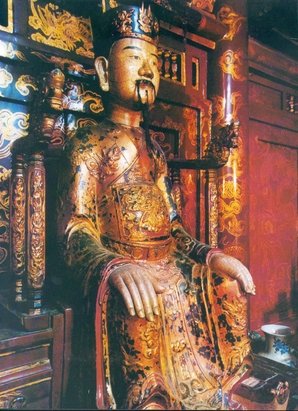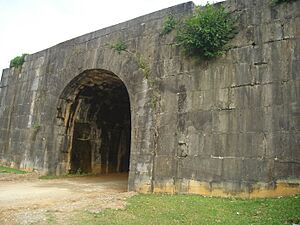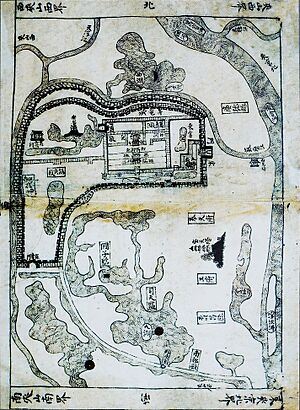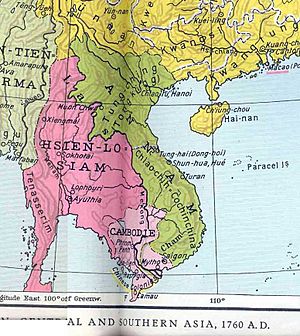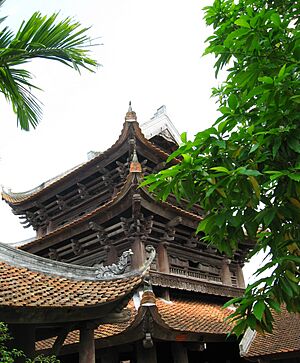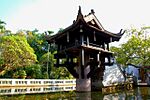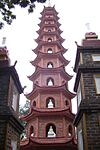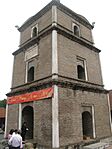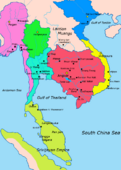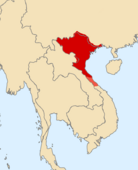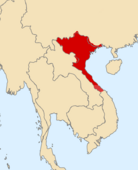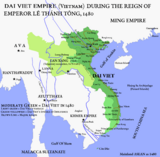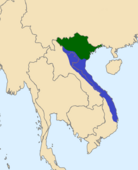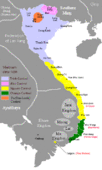Đại Việt facts for kids
Quick facts for kids
Đại Cồ Việt (968–1054)
Đại Việt (1054–1804) 大瞿越國
Đại Việt Quốc (大越國) |
|||||||||
|---|---|---|---|---|---|---|---|---|---|
| 968–1400 1428–1804 |
|||||||||
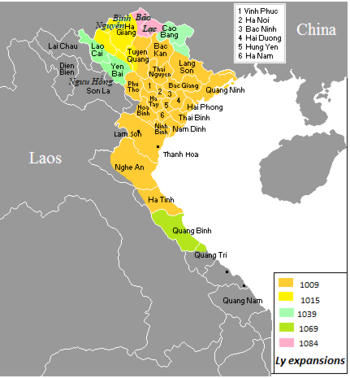
Đại Việt under Lý dynasty in 11th century
|
|||||||||
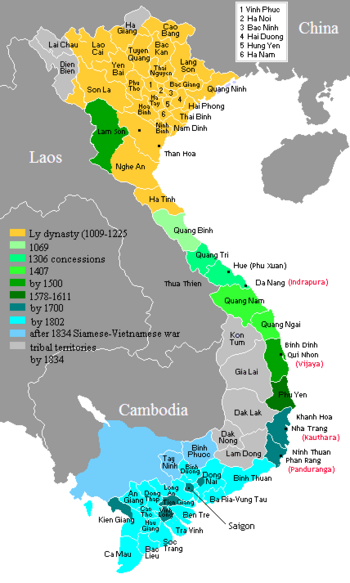
Đại Việt's territory expansion from 11th to 19th century
|
|||||||||
| Capital | Hoa Lư (968–1010) (Thăng Long/ Đông Kinh) (1010–1398, 1428–1789) Tây Đô (1398-1407) Phú Xuân (1789–1804) |
||||||||
| Official languages | Vietnamese Văn ngôn (official script since 1174) |
||||||||
| Common languages | Viet–Muong (Northern Vietic) languages Kra–Dai languages Other Southeast Asian Languages |
||||||||
| Religion | Buddhism (State religion from 968 to 1400) Confucianism Taoism Đạo Lương Hinduism Islam Catholicism |
||||||||
| Government | Absolute monarchy (968–1533, 1788–1804) Monarchic feudal military dictatorship (1533–1788) |
||||||||
| Emperor | |||||||||
|
• 968–980 (first)
|
Đinh Bộ Lĩnh | ||||||||
|
• 1802–1804 (last)
|
Gia Long | ||||||||
| Military dictators | |||||||||
|
• 1533–1545 (first)
|
Nguyễn Kim | ||||||||
|
• 1545–1786
|
Trịnh lords | ||||||||
|
• 1786–1788 (last)
|
Nguyễn Huệ | ||||||||
| Historical era | Postclassical era to Late modern period | ||||||||
|
• End of Third Chinese domination of Vietnam
|
905 | ||||||||
|
• Established.
|
968 | ||||||||
|
• Lý Thánh Tông shortened his empire's name from Đại Cồ Việt to Đại Việt
|
1054 | ||||||||
|
• Đại Ngu Kingdom under Hồ Quý Ly
|
1400–1407 | ||||||||
|
• Ming rule
|
1407–1427 | ||||||||
|
• Lê Thánh Tông's reign and expansions
|
1460–1497 | ||||||||
|
• Northern and Southern dynasties
|
16th century–1802 | ||||||||
| 1804 | |||||||||
| Population | |||||||||
|
• 1200
|
1,200,000 | ||||||||
|
• 1400
|
1,600,000 | ||||||||
|
• 1539
|
5,625,000 | ||||||||
| Currency | Vietnamese văn, banknote | ||||||||
|
|||||||||
| Today part of | |||||||||
Đại Việt (meaning "Great Việt") was an important kingdom in Southeast Asia. It existed for a long time, from the 10th century to the early 19th century. Its main area was around what is now Hanoi, in northern Vietnam.
The kingdom was first called Đại Cồ Việt in 968. This name was given by Đinh Bộ Lĩnh after he brought peace to the land. Later, in 1054, Emperor Lý Thánh Tông changed the name to Đại Việt. The kingdom lasted until 1804, when Emperor Gia Long renamed it Việt Nam.
Đại Việt's history is divided into several periods, ruled by different families or "dynasties." These included the Đinh, Early Lê, Lý, Trần, Hồ, Later Lê, Mạc dynasty, and Tây Sơn dynasty. Sometimes, the kingdom was unified, and other times it was split into different parts ruled by different groups. Over centuries, Đại Việt expanded its borders, growing to cover much of what is modern-day Vietnam.
Đại Việt was a powerful and important state in its region. It slowly took over lands from neighboring kingdoms like Champa and Cambodia. This expansion helped shape the country of Vietnam we know today. Đại Việt is seen as the main ancestor of modern Vietnam and its culture.
Contents
- Understanding the Name "Việt"
- History of Đại Việt
- Early Beginnings
- Founding the Kingdom
- Đại Cồ Việt (968–1054)
- Flourishing Period: Lý and Trần Dynasties (1054–1400)
- Hồ Dynasty (1400–1407)
- Ming Invasion and Occupation (1407–1427)
- Revival of Đại Việt: The Later Lê Dynasty (1428–1527)
- Mạc Dynasty (1527–1593)
- Revival Lê Dynasty: Trịnh and Nguyễn Control (1593–1789)
- Tây Sơn Wars and Nguyễn Dynasty (1789–1804)
- Political Structure
- Economy of Đại Việt
- Art and Religion
- Maps
- Timeline of Dynasties
- See also
Understanding the Name "Việt"
The word Việt (or Yue) has a long history. It was first used in ancient China around 1200 BC. Back then, it might have referred to a group of people or a leader.
How "Việt" Changed Over Time
- Early Use: In the 7th to 4th centuries BC, Yue referred to a specific state in China and its people.
- Broader Meaning: From the 3rd century BC, it was used for many non-Han Chinese groups in southern China and northern Vietnam. These groups were called things like Minyue and Luoyue.
- "Baiyue": The term Baiyue (meaning "Hundred Yue") appeared around 239 BC. It described many different tribes in the south. These tribes had different languages and customs.
- Geopolitical Term: Over time, Yue became more about a place or a political area, not just a group of people. Even during Chinese rule, many states in the old Yue region used the name Yue for their land.
- Becoming "Việt": When the word Yue came into the Vietnamese language around the time of the Tang dynasty (618–907), it changed. It became Việt, which is what the Vietnamese people called themselves. This shows how their identity became linked to this ancient name.
The Name "Đại Cồ Việt"
Đinh Bộ Lĩnh chose the name Đại Cồ Việt for his kingdom in 966. It likely means "Great Việt." The word Cồ might have come from a local term for "great" or "region." This name was used until 1054.
The Name "Đại Việt"
In 1054, Emperor Lý Nhật Tôn shortened the name from Đại Cồ Việt to Đại Việt. This means "Great Việt." This more formal name had been used even before 1054. It was found on old brick writings from Hoa Lư, the first capital.
History of Đại Việt
Early Beginnings
For about a thousand years, the area of northern Vietnam was ruled by different Chinese dynasties. It was known by names like Giao Chỉ and Annan.
The Red River Delta in northern Vietnam was home to many different groups of people. These groups had their own languages and cultures. Before the Chinese arrived, cultures like the Phùng Nguyên and Dong Son culture existed there. They were skilled in metalwork. The Chinese often called these groups "Yue" or "barbarians."
It's important to know that there wasn't a single "Vietnamese" identity during this long period of Chinese rule. People were part of many different communities.
Local Cultures and Chinese Influence
One group, the Li-Lao people, lived in the region from about 200 to 750 AD. They were known for making large bronze drums. These groups often resisted Chinese rule. This helped keep a balance between Chinese culture and local traditions.
Over time, Chinese rule had a big impact on the languages and cultures of northern Vietnam. Many local languages started using Chinese writing or writing systems based on Chinese.
Founding the Kingdom
Before Đại Việt became independent, the area was part of the Chinese Tang dynasty. In the late 9th century, local leaders and hill dwellers rebelled against the Tang. The Tang eventually pulled out in 880.
A local family, the Khúc, took control of the Red River Delta in the early 10th century. They were appointed as governors by Chinese dynasties. However, they didn't try to create a fully independent state.
Achieving Independence
- Southern Han Invasion: In 930, the Southern Han state invaded and removed the Khúc family.
- Dương Đình Nghệ's Revolt: In 931, Dương Đình Nghệ, a local leader, drove out the Southern Han.
- Ngô Quyền's Victory: In 937, Dương Đình Nghệ was killed. His son-in-law, Ngô Quyền, fought and defeated the Southern Han fleet on the Bạch Đằng River in 938. This was a major victory for independence.
After this win, Ngô Quyền declared himself king in 939. He set up his capital at Cổ Loa. However, after his death in 944, his kingdom faced internal struggles. His brother-in-law took power, and then his sons ruled together for a while. After Ngô Quyền's sons died, the region fell into chaos, with many local warlords fighting each other.
Đại Cồ Việt (968–1054)
A strong leader named Đinh Bộ Lĩnh emerged. He spent two years fighting and bringing all the warlords under his control. Around 968, Đinh Bộ Lĩnh established the kingdom of Đại Cồ Việt. He moved the capital to Hoa Lư and called himself emperor.
- Early Rule: Đinh Bộ Lĩnh sent envoys to the Song dynasty in China to build relationships. Buddhist leaders were given important roles in the government. Coins were also made.
- Challenges: In 979, Đinh Bộ Lĩnh and his son were killed. A general named Lê Hoàn took control with the support of the queen.
- Defending the Kingdom: In 981, the Song dynasty invaded Đại Cồ Việt, but Lê Hoàn successfully pushed them back. He also attacked the neighboring kingdom of Champa in 982.
- New Dynasty: After Lê Hoàn died in 1005, there was a civil war among his sons. Eventually, Lý Công Uẩn took the throne in 1009, starting the Lý dynasty.
Flourishing Period: Lý and Trần Dynasties (1054–1400)
Lý Dynasty (1009–1226)

Emperor Lý Thái Tổ moved the capital to Đại La in 1010 and renamed it Thăng Long, which is now Hanoi. He also created a tax system. His rule was mostly peaceful, and he laid the foundation for a stable Vietnamese state.
- Strengthening the State: Lý Thái Tổ's son and grandson, Lý Thái Tông and Lý Thánh Tông, continued to make the state stronger.
- Expansion: Đại Việt expanded its territories. They attacked Champa, raided southern Chinese port cities, and brought the Nùng people under control.
- Chinese Influence: Chinese culture began to influence Vietnam. The first civil service exams, like those in China, were held in 1075. Chinese writing became the official script in 1174.
- Renaming to Đại Việt: In 1054, Lý Thánh Tông officially changed the kingdom's name to Đại Việt.
- Defending Against Song: In 1075, the military leader Lý Thường Kiệt led an attack on southern China. The Song emperor then launched a large invasion of Đại Việt in 1076. However, Lý Thường Kiệt defeated the Song army at the Battle of the Cầu River. Peace was made in 1084, and the Song recognized Đại Việt as a sovereign kingdom.
- Later Lý Rulers: The Lý dynasty continued to rule for many years. However, by the late 1100s, other powerful families began to gain influence in the court.
Trần Dynasty (1226–1400)
In 1225, the Trần family took power. Trần Cảnh became the first emperor of the new Trần dynasty.
- Centralization: The Trần emperors made the government more centralized. They organized civil exams and built royal schools. They also worked on large projects like building dikes to control rivers.
- Mongol Invasions: In 1257, the Mongol Empire invaded Đại Việt. The Trần army was initially defeated, and the capital Thăng Long was captured. However, the Mongols soon retreated.
- Defeating Kublai Khan: Later, Kublai Khan, the Mongol emperor, launched two more invasions of Đại Việt in 1285 and 1288. The Vietnamese, led by Prince Trần Hưng Đạo, bravely fought back. In 1288, they won a major naval victory at the Bạch Đằng River, ending the Mongol threat.
- Decline: By the 14th century, Đại Việt began to decline. There were natural disasters like droughts and floods, which led to famines and unrest. Rebellions by peasants also weakened the royal power.
- Champa Invasions: The kingdom of Champa, under King Po Binasuor, invaded Đại Việt multiple times from 1371 to 1383, even ransacking Thăng Long. The war with Champa ended in 1390 when Po Binasuor was killed.
Hồ Dynasty (1400–1407)
Hồ Quý Ly, a powerful minister, took control of the Trần court. He made several reforms, like using paper money instead of copper coins. In 1400, he overthrew the Trần emperor and became the ruler of Đại Việt. He moved the capital to Tây Đô and briefly changed the kingdom's name to Đại Ngu (meaning "Great Joy/Peace").
Ming Invasion and Occupation (1407–1427)
In 1406, the Ming dynasty of China invaded Đại Ngu. The Vietnamese army, unprepared and lacking support, was defeated. The Ming empire then ruled the region for 20 years.
- Impact of Ming Rule: The Ming tried to make the Vietnamese more like the Chinese. They opened Confucian schools and banned some Vietnamese traditions. Many Vietnamese scholars were sent to China for re-education. This period had a big impact on Vietnamese culture and government.
Revival of Đại Việt: The Later Lê Dynasty (1428–1527)
Lam Sơn Uprising
Lê Lợi, a peasant's son, led a rebellion against the Chinese occupation starting in 1418. With help from Nguyễn Trãi, a scholar, Lê Lợi's forces fought for nine years. They eventually drove the Chinese out in 1427. In April 1428, Lê Lợi became Emperor of a new Đại Việt, starting the Later Lê dynasty. He made Hanoi the eastern capital.
Rule of Lê Lợi and Lê Thánh Tông
- Lê Lợi's Rule: Lê Lợi focused on building a strong, centralized government. He encouraged educated men to serve the monarchy.
- Lê Thánh Tông's Reforms: After Lê Lợi's death, his grandson Lê Thánh Tông (r. 1460–1497) became emperor. He made many important reforms. He centralized the government, created a strong bureaucracy, and improved education and laws. He also promoted classical scholarship and culture. Hanoi became a center of learning.
- Expansion Under Lê Thánh Tông: Lê Thánh Tông used his strong army to expand the kingdom. In 1471, he invaded Champa, causing great destruction to their civilization. He also invaded Laos in 1479. Vietnamese goods, especially ceramics, were traded across Southeast Asia and beyond.
Decline and Civil War
After Lê Thánh Tông's death in 1497, Đại Việt entered a period of trouble. There were problems with farming, rapid population growth, and corruption. Many weak Lê kings ruled, and fighting broke out between powerful families like the Trịnh and Nguyễn. In 1516, a peasant rebellion attacked the capital, destroying the royal palace.
Mạc Dynasty (1527–1593)
Mạc Đăng Dung, a military officer, stepped in to restore order. In 1527, he forced the Lê king to give up the throne and started the Mạc dynasty. However, Nguyễn Kim, a noble loyal to the Lê, rebelled against the Mạc. He brought back a Lê descendant to rule from exile. This started a long period of civil war between the Mạc (the "northern court") and the Lê loyalists (the "southern court").
Revival Lê Dynasty: Trịnh and Nguyễn Control (1593–1789)

The Lê loyalists, helped by the Trịnh and Nguyễn families, pushed the Mạc out of Hanoi in 1592. The Trịnh family then controlled the northern part of Đại Việt, known as Đàng Ngoài ("Outer Realm"). The Nguyễn family controlled the southern part, known as Đàng Trong ("Inner Realm").
- Trịnh-Nguyễn War: The Trịnh and Nguyễn families fought a long civil war from 1627 to 1673. It ended in a peace treaty, dividing the kingdom. The Lê king remained a figurehead, with real power held by the Trịnh lord in the north and the Nguyễn lord in the south.
- Tây Sơn Rebellion: This division lasted until 1771, when three brothers, Nguyễn Nhạc, Nguyễn Huệ, and Nguyễn Lữ, led a peasant revolution. They overthrew the Nguyễn, Trịnh, and Lê dynasties. In 1789, the Tây Sơn defeated a Chinese attempt to restore the Lê dynasty.
Tây Sơn Wars and Nguyễn Dynasty (1789–1804)
The Tây Sơn brothers ruled different parts of the kingdom. However, a descendant of the Nguyễn lords, Nguyễn Ánh, fought back. After many years, Nguyễn Ánh defeated the Tây Sơn and reunified the kingdom. In 1802, he became Emperor Gia Long and founded the Nguyễn dynasty. He changed the name of the country from Đại Việt to Việt Nam in 1804.
Political Structure
Early Đại Việt (Before 1200s)
In the early days, Đại Việt was like a "mandala state." This means the king had influence over a wide area, but only directly controlled a few central regions. Outer areas were often ruled by local clans who were allied with the king, often through religious ties like Buddhism. The king was seen as a powerful leader, but the government wasn't very big yet.
Trần and Hồ Dynasties
During the Trần dynasty (13th and 14th centuries), the state became more centralized. Taxes were collected, and official records were kept. The emperor and royal family held most of the power. They also built large irrigation systems to help with farming. Confucianism became more important, alongside Buddhism.
The kingdom faced many challenges during this time, including Mongol and Champa invasions, unrest, and diseases. Hồ Quý Ly tried to fix these problems by changing the government, but his actions led to more political trouble.
Later Lê and Divided Kingdom
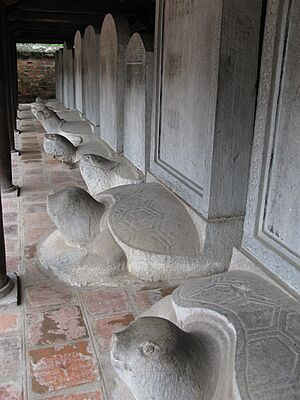
From the 1460s, Emperor Lê Thánh Tông reformed the government based on the Chinese Ming dynasty model. He created ministries and courts, making the government very centralized. Đại Việt was divided into provinces, each with its own government. He also published a new legal code.
Lê Thánh Tông did not favor foreign trade. He encouraged farming and state-controlled crafts. His reforms made the king and the government very powerful.
After Lê Thánh Tông's death, the kingdom faced civil wars. The Mạc dynasty took power, but the Lê loyalists, supported by the Trịnh and Nguyễn families, fought back.
Divided Rule
After the Lê-Mạc war, the Trịnh and Nguyễn families became the strongest powers. They divided the kingdom into two parts:
- Đàng Ngoài (Outer Realm): Ruled by the Trịnh family in the north. They held most of the power, while the Lê king was just a figurehead.
- Đàng Trong (Inner Realm): Ruled by the Nguyễn family in the south. They acted like independent rulers.
Even though the kingdom was divided, both the Trịnh and Nguyễn lords still respected the Lê king. This helped keep the idea of a unified Vietnamese state alive.
Economy of Đại Việt
Đại Việt was mainly a farming kingdom, especially around the Red River Delta. Most records from this time talk about farming, irrigation, and land. Trade was not as important as farming. Emperor Lê Thánh Tông once said, "Do not cast aside the roots (agriculture) and pursue the insignificant trade." This shows that leaders valued farming more than trade.
Đại Việt had only one main port, Van Don, near Ha Long Bay. This port was far from major sea routes. Because of this, many merchant ships from other countries would stop at ports in Champa instead.
Đại Việt was not as well-known to distant parts of the world as Champa was. However, some Arab and Persian historians did mention Đại Việt in their writings.
Art and Religion
Buddhism arrived in Vietnam around the 1st century AD. By the 8th century, a type of Buddhism called Mahayana Buddhism was very popular in the Red River Delta. Several dynasties that ruled Đại Việt were Buddhist.
- Buddhist Influence: Kings, the court, and society were deeply Buddhist. Buddhist teachings were even written on stone pillars. Emperors built temples and statues. The Lý dynasty, for example, combined Buddhism with local folk beliefs and Indian deities.
- Monasteries and Wealth: Buddhist monasteries, supported by the royal family, owned a lot of farmland and wealth. Temples were often built with timber and had pagodas made of bricks or stone.
- Decline and Revival: Vietnamese Buddhism declined in the 15th century due to Chinese influence that favored Confucianism. However, it was revived later, from the 16th to 18th centuries. Today, Vietnam is a mostly Buddhist country.
- Vietnamese Buddhist temples
-
The One Pillar Pagoda, constructed around 1050 by Emperor Lý Thái Tông and destroyed in 1952
Maps
-
Đại Việt during Lý dynasty in 1100
-
Đại Việt during Trần dynasty (1225–1400) and Hồ dynasty (1400–1407)
-
Đại Việt during the reign of Lê Thánh Tông (c. 1480)
-
Đại Việt during Tây Sơn dynasty
Timeline of Dynasties
Đại Việt existed from 968 to 1804.
| Ming domination | Nam–Bắc triều * Bắc Hà–Nam Hà | French Indochina | ||||||||||||||||||
| Chinese domination | Ngô | Đinh | Early Lê | Lý | Trần | Hồ | Later Trần | Lê | Mạc | Revival Lê | Tây Sơn | Nguyễn | Modern time | |||||||
| Trịnh lords | ||||||||||||||||||||
| Nguyễn lords | ||||||||||||||||||||
| 939 | 1009 | 1225 | 1400 | 1427 | 1527 | 1592 | 1788 | 1858 | 1945 | |||||||||||
| History of Vietnam (by names of Vietnam) |
 |
||||||||||||||||||||||||||||||||||||||||||||||||||||||
|---|---|---|---|---|---|---|---|---|---|---|---|---|---|---|---|---|---|---|---|---|---|---|---|---|---|---|---|---|---|---|---|---|---|---|---|---|---|---|---|---|---|---|---|---|---|---|---|---|---|---|---|---|---|---|---|
|
|||||||||||||||||||||||||||||||||||||||||||||||||||||||
See also
- Champa
- List of monarchs of Việt Nam


